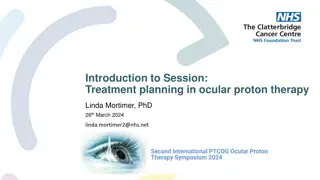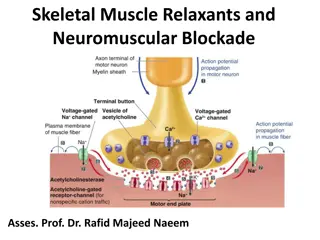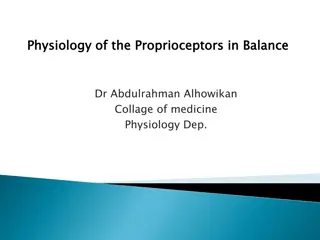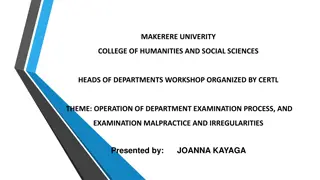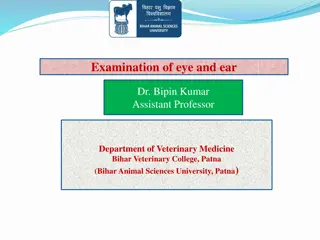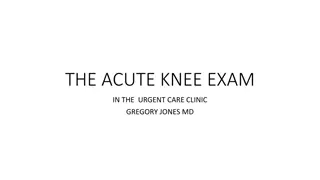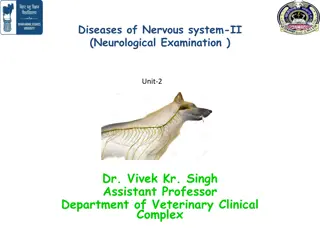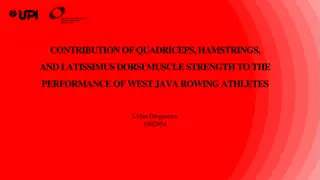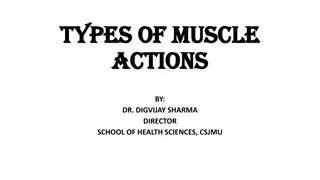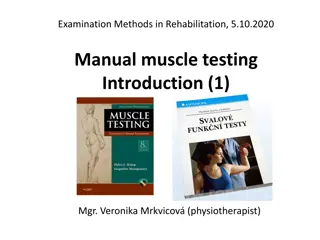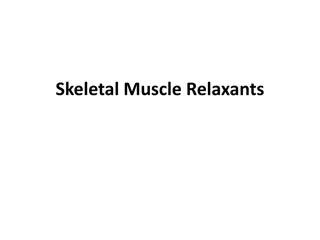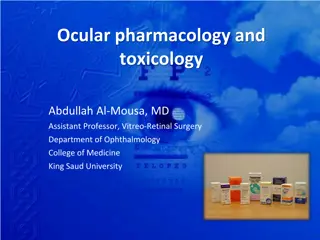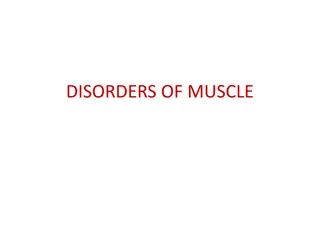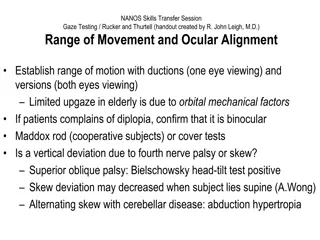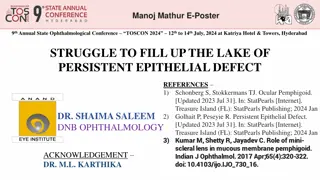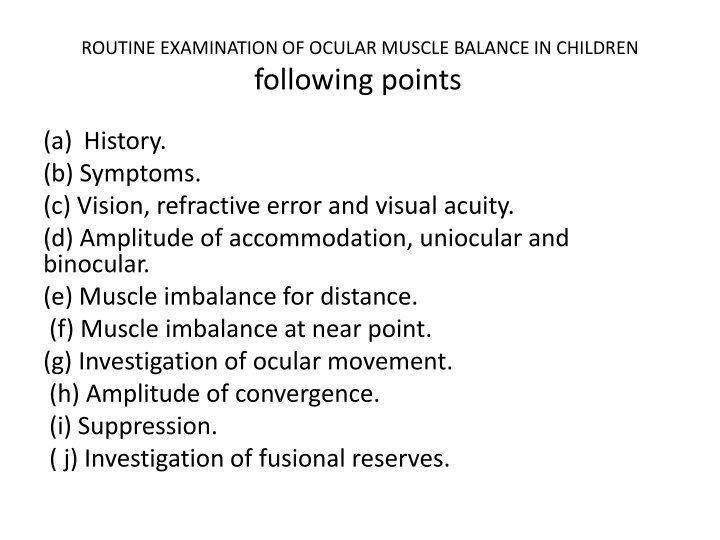
Routine Examination of Ocular Muscle Balance in Children
History, symptoms, vision assessment, accommodation, muscle imbalance evaluation, investigation of ocular movement, convergence, suppression, and fusional reserves are essential aspects in examining ocular muscle balance in children. It is important to consider hereditary influences, refractive errors, and near and distance muscle imbalances for a comprehensive evaluation.
Download Presentation

Please find below an Image/Link to download the presentation.
The content on the website is provided AS IS for your information and personal use only. It may not be sold, licensed, or shared on other websites without obtaining consent from the author. If you encounter any issues during the download, it is possible that the publisher has removed the file from their server.
You are allowed to download the files provided on this website for personal or commercial use, subject to the condition that they are used lawfully. All files are the property of their respective owners.
The content on the website is provided AS IS for your information and personal use only. It may not be sold, licensed, or shared on other websites without obtaining consent from the author.
E N D
Presentation Transcript
ROUTINE EXAMINATION OF OCULAR MUSCLE BALANCE IN CHILDREN following points (a) History. (b) Symptoms. (c) Vision, refractive error and visual acuity. (d) Amplitude of accommodation, uniocular and binocular. (e) Muscle imbalance for distance. (f) Muscle imbalance at near point. (g) Investigation of ocular movement. (h) Amplitude of convergence. (i) Suppression. ( j) Investigation of fusional reserves.
(a) History. Questions should be asked with a view to obtaining details of previous illness or accident, such as measles, diphtheria, Graves disease, etc. inquiry regarding ocular disorders of Near relatives in order that hereditary influences, as it is found that where a history of squint in the family is disclosed the patient is less tractable to treatment which consequently occupies a relatively protracted period. Details of age of onset of the symptoms and relative time of any illness or accident is of value, while particular care taken to observe any anomalous position of the head or an unusual orbits. (b) Symptonas. should they resemble those common to bodily diseases close enquiry regarding general health (c) Vision, Refractive Error and Visual acuity. uniocularly and binocularly are important, as muscle imbalance may result from amblyopia, scotomata, etc., an examination under a cycloplegic is advisable in order to determine the extent of any latent error of refraction. note must also be made of any difference in the degree of deviation without and with correction of the refractive error. (d) Accommodation. The amplitude of of each eye taken separately and als binocularly. The result of the binocular test may show an increase over that found uniocularly, but it is more important to note a difference in the amplitude of either eye. (e) Imbalance at Distance. Cover Test for heterophoria or strabismus. The subject should be directed to fix a definite object, such as a single letter on the test chart while one eye is covered by a card. If when the card is removed the eye previously covered makes a movement to regain its normal position heterophoria is indicated. If, however, a definite deviation is disclosed and the eye makes no movement to recover its normal position, strabismus is present. Each eye should be covered in turn and the deviation noted ; a difference in degree will disclose incomitancy, denoting paresis or paralysis of an individual muscl e
. To assess the degree of deviation in heterophoria the Maddox rod or phorometer. The writer prefers to use a green filter over one eye and a red Maddox rod over the other in order to ensure thorough dissociation. In strabismus a rough estimate of the degree of deviation may be made by applying the Hirschberg test in which the subject is directed to gaze at a small source of light, such as an ophthalmscope bulb, at 33 cm. The position of the corneal reflex in the deviated eye is then noted ; if it falls on the edge of a normal sized pupil the degree of deviation is approximately is 15 the centre of the iris 30", or if on the liiiibus 45 ". The test should be made first with one eye fixing the lamp and then with the other. In determining whether the eyes are straight when in the primary position confrontation is essential as a pseudo deviation is frequently in slight latero-version. The state of the muscle balance at distance has an important influence on the determination of the prescription given for the correction of the refractive error (f) Imbalance at Near Point. For routine purposes Maddox wing test used, or a dis-associating prism, i.e., one of sufficient power to produce diplopia; the degree of deviation being determined by the power of the prism found necessary to bring the two images into alignment one with the other. The relation between the imbalance at distance and near point is of importance in determining whether the heterophoria is due to excessive divergence, weakness of convergence or excessive convergence.. When considering muscle imbalance for near point physiological exophoria of not more than 6A to 7A must be taken into account (g) Investigation of Ocular Movmments. the most important step if any suspicion of incomitancy or an anomalous position of head or orbits observed. The normal action of individual muscle is considered first-its effect on laterial rotation, elevation, depression and torsion. Secondly, the action of individual muscles in associated movements needs close attention. both uniocularly and binocularly. the subject, with one eye occluded, is directed to gaze at the tip of a pencil held directly in front of the eyes at a distance of approximately 50 cm. With the head of the subject held stationary the pencil is moved through the six cardinal positions and the extent of the excursions of the globe noted. The eye should be able to turn laterally in either direction until the limbus touches the inner or outer canthus respectively and also turn upwards or downwards to the full extent. If, however, the eye is able to make full excursion or approximately so but
. at the extreme end of the excursion a jerky nystagmoid movement is produced paresis is indicated. repeated with the other eye covered, a similar examination with both eyes uncovered since a deviation due to a paretic muscle must increase in the field of the affected muscle. Heterophoria is frequently regarded as a condition in itself instead of being viewed as an end result of some abnormal or disordered function To demonstrate incomtancy in heterophoria a small source of light may be viewed through a dis- associating prism and the two images brought into line by prism power. The head is then rotated laterally and any deviation from alignment by one of the two images is noted. (If under test the exophoria is increased when looking to the right it may he produced by a paretic left m rectus; if increased when looking left the righ tm rectus is suspect If an esophoria increases when looking to the right the right external rectus is probably at fault; if it increases when looking left then the left l rectus may be paretic. If esophoria increases when looking both to right and left then both external recti are paretic. If. however, the degree of deviation remains constant no matter in which direction the eyes are turned it is necessary to determine whether condition is clue to excess or insufficiency of divergence or convergence. Should the deviation be more ahnorml at distance then divergence excess (exo) or weakness (eso) is indicated but if the deviation is more abnormal at near point convergence (exo) or excess (eso) is revealed.) .Intermittent squint demands the elicitation of details regarding the circunimstances attending its manifestation. If complains that the squint is during fatigue an element of palsy is to suspected. Should complaint be made of squint manifested on waking it may be that natural result of opening the eyes to bright (h) Amplitude of Convergence . (The patient is instructed to hold a pencil at arm's length and gaze fixedly at its tip. The pencil is then approached towards the eyes and the position noted where one eye gives up and diverges. The normal near point of convergence is considered to be 8 cm from a point situated from midway between the two eyes. The quality of fixation should also be observed
(i) Intermittent suppression of vision in one eye or alternately in either eye is by no means uncommon and is responsible for ocular discomfort. prism stereoscope Worthdot\4 dot ( j ) Investigation of Fusional Reserves. frequently discloses information regarding muscle tonus and the ability of convergence. To measure fusional reserves the prisms stereoscope instrument. For distance the subject is requested to regard a single letter on the test chart, usually 6/9, while prism power base-out is turned up, and indicate when the letter becomes indistinct, the prism power required to produce this state of affairs is regarded as being the measure of positive fusional convergence for distance ; similarly, to measure the negative fusional reserve, prism power base-in is turned up in the instrument until the letter under regard appears to be double. For measurement of fusional reserves at near the procedure is similar except that the target is situated at near point and consists of a single Jaeger I letter or a single line of fine type arranged vertically. the result of acquisition of definite knowledge, instead of a degree of supposition which may lead to a succession Among oculists there has been a somewhat general agreement as to the desirability of using cycloplegia in the majority of refractive examinations i-Suppression.

